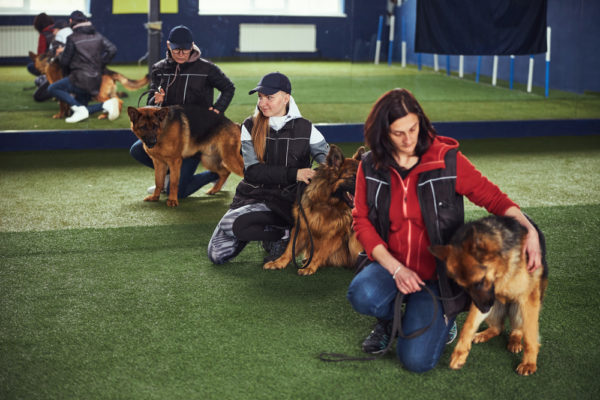Leading Canine Educating Methods Every Proprietor Need To Know

Positive Reinforcement Techniques
Making use of favorable reinforcement strategies is necessary for efficient canine training, as it fosters a relying on bond in between the trainer and the pet dog. This approach concentrates on rewarding preferable habits instead than penalizing undesirable ones, creating an atmosphere for learning. Incentives can consist of deals with, appreciation, or play, which motivate dogs to duplicate the habits that gain them these rewards.

Moreover, this method boosts the dog's excitement for training sessions. They are a lot more involved and receptive when dogs connect training with positive experiences. Dog training. Beyond prompt therapy, positive support urges a collaborative connection in between the pet and trainer, decreasing anxiousness and fear
To make the most of efficiency, it is critical to supply rewards quickly, guaranteeing the pet attaches the actions with the support. Basically, favorable support techniques not only yield better-trained dogs but also promote a harmonious partnership in between pet and proprietor.
Clicker Training Approach
The clicker training approach is an extremely reliable technique that builds on the principles of favorable reinforcement by including a distinct sound to mark desired habits. This method makes use of a small handheld device that produces a clicking sound, enabling instructors to connect with their dogs in a clear and prompt fashion. When a pet dog carries out a behavior that the proprietor wishes to encourage, the clicker is triggered, complied with by a reward, usually in the form of treats or appreciation.
The trick to effective clicker training depends on consistency and timing. It is essential to click at the exact minute the preferred habits takes place, guaranteeing that the pet dog connects the audio with the activity and the succeeding incentive. This technique not only boosts communication but also fosters a more powerful bond between the owner and the dog, as it encourages involvement and interaction during training sessions.
Clicker training can be related to a selection of commands and habits, from fundamental obedience to more intricate methods. Its flexibility and effectiveness make it a preferred technique among professional instructors and family pet owners alike, paving the way for a well-trained and responsive canine buddy.
Leash Training Essentials
Effective chain training is crucial for making certain a satisfying and safe strolling experience for both canines and their proprietors. A flat collar might work for some pets, while others may benefit from a harness that reduces drawing.
Introduce your canine to the leash progressively, permitting them to discover it in a comfortable setting. This entails rewarding your canine for strolling close to you instead than drawing ahead.
If your pet dog starts to draw, quit strolling right away. Additionally, practice different strolling atmospheres to help your pet adjust to interruptions.
Regular method will certainly solidify your dog's understanding of leash decorum. Keep in mind that leash training is an ongoing procedure; perseverance and consistency will certainly produce the very best outcomes, promoting a positive experience for both you and your canine companion.
Socializing Approaches
Socializing is an important element of pet dog training that ought to preferably start throughout puppyhood but can you can find out more be useful at any age. Efficient socialization assists canines develop confidence and lowers the probability of behavior concerns. To carry out successful socializing techniques, subject your dog to a range of settings, individuals, and various other pets.
Begin with controlled setups, such as puppy courses or organized playgroups, where young canines can communicate safely. Progressively introduce your dog to brand-new experiences, including different noises, surface areas, and tasks. Ensure these experiences are rewarding and positive to develop a complacency.
For grown-up canines or those doing not have exposure, begin with low-stress scenarios. Short, favorable interactions with tranquil pets and pleasant people can produce favorable associations. Make use of deals with and praise to enhance preferable behaviors during these experiences.

Uniformity and Perseverance
Identifying the value of consistency and perseverance in canine training is essential for attaining long lasting results. Irregular training can lead to confusion, making it hard for the pet dog to realize commands or behaviors, inevitably impeding progress.
Pet dogs, like people, discover at their own speed. This fosters a trusting relationship in between the dog and proprietor, urging an extra willing and passionate student.
To cultivate uniformity and perseverance, develop a regular training routine, make use of the exact same commands, and make certain that all family participants apply the same training principles - Dog training. By doing so, you develop a stable setting conducive to finding out, enabling your dog to develop and grow into a mannerly buddy
Conclusion
To conclude, efficient canine training strategies, such as positive support, clicker training, and proper chain training, are vital for cultivating a healthy and balanced owner-dog relationship. In addition, implementing socialization techniques and maintaining uniformity and visit the site persistence throughout the training process adds substantially to a pet's total wellness. By integrating these methods, canine proprietors can promote the growth of useful reference well-adjusted, obedient family pets, inevitably boosting the lifestyle for both the proprietor and the dog.
Among the most prominent methods are positive reinforcement, remote control training, and chain training, each offering one-of-a-kind benefits that add to a well-behaved pet dog. As we check out these basic techniques, it ends up being obvious that grasping their subtleties can dramatically impact the training experience and the canine's overall habits.Using positive reinforcement techniques is necessary for reliable dog training, as it promotes a relying on bond in between the dog and the trainer.In verdict, reliable pet training strategies, such as favorable support, remote control training, and appropriate leash training, are essential for fostering a healthy and balanced owner-dog partnership. By incorporating these methods, canine proprietors can facilitate the growth of well-adjusted, obedient pet dogs, eventually boosting the top quality of life for both the pet and the proprietor.